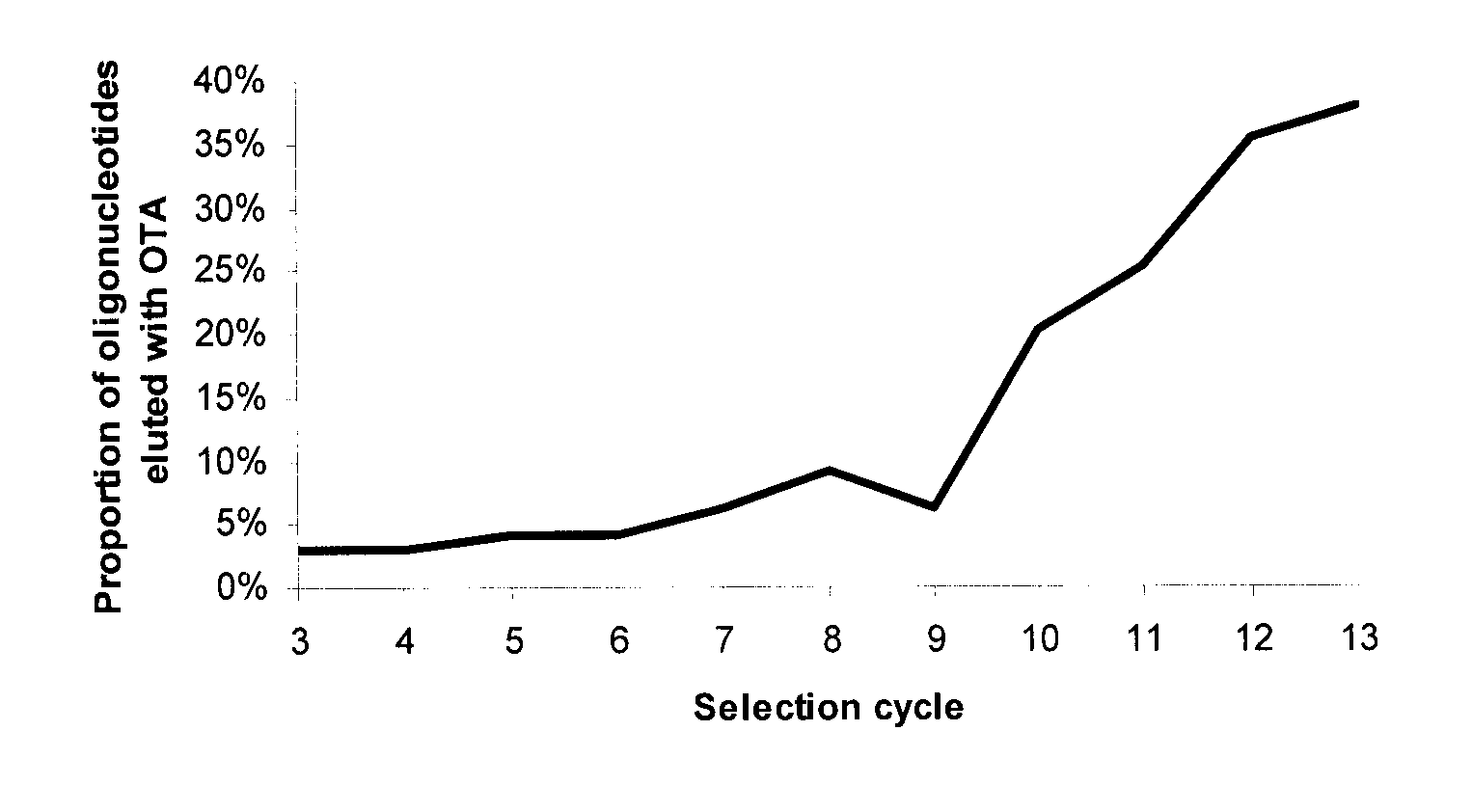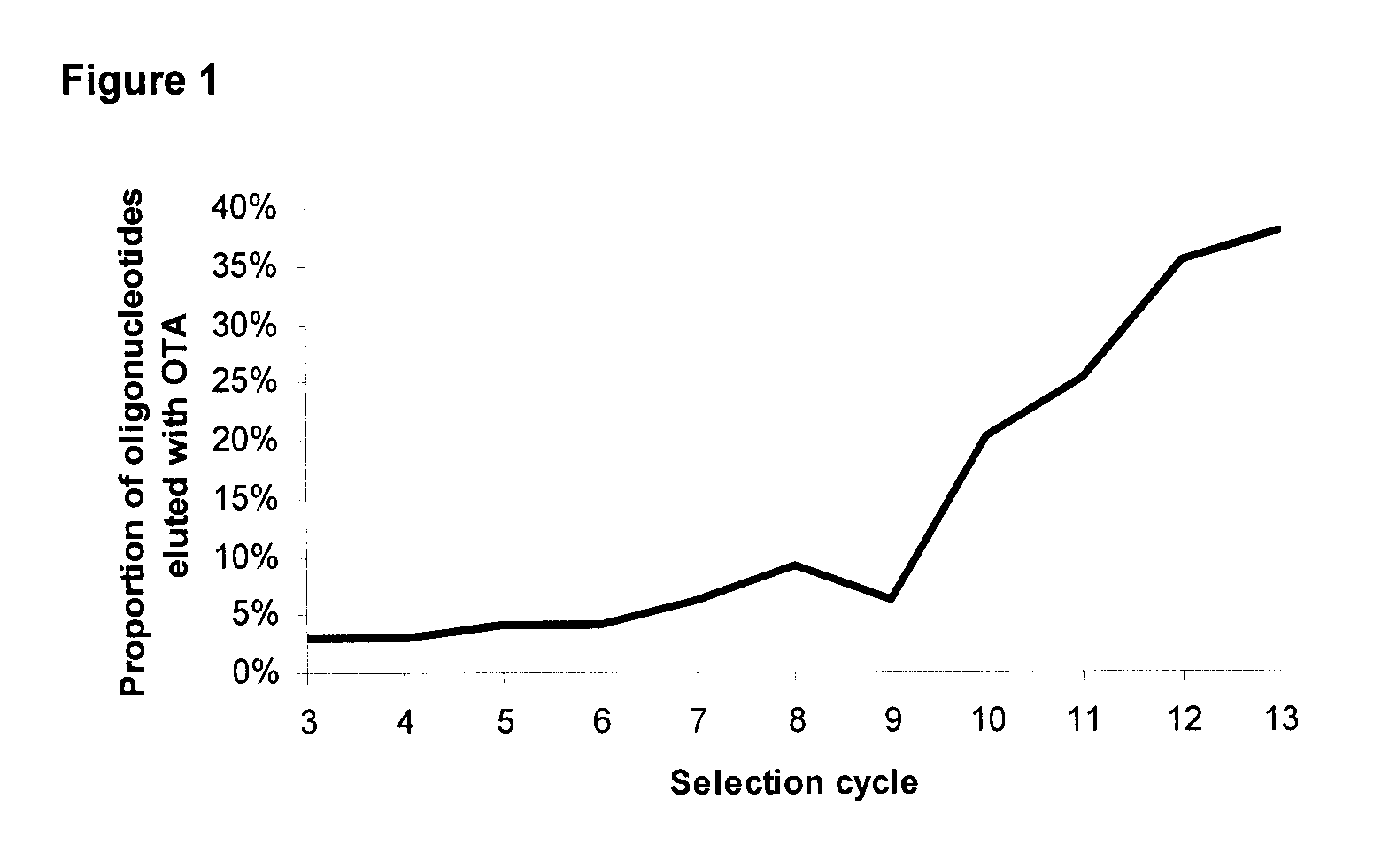Method of Mycotoxin Detection
a mycotoxin and detection method technology, applied in the field of dna oligonucleotides, can solve the problems of weak mineral/mycotoxin interaction, inability to estimate the achievable level of sensitivity, and inability to detect the level of sensitivity, etc., to achieve strong fluorescence and high performance
- Summary
- Abstract
- Description
- Claims
- Application Information
AI Technical Summary
Benefits of technology
Problems solved by technology
Method used
Image
Examples
example 1
Identification of DNA Ligands for a Mycotoxin
[0086]In the present invention an initial library was created with two regions of known sequence flanking 30 nucleotides of unknown sequence. The two regions of known sequence were used as complementary sites for PCR amplification with the primers listed as SEQ ID NO: 14 and SEQ ID NO: 15. A quantity of this library was used that would correspond to 1015 sequences for the initial round of selection. OTA (Romer Labs™) was dissolved to a concentration of 5 μmol in 200 μL of DMSO (10 mM) and mixed with 500 μmol of 1-Ethyl-3-[3-dimethylaminopropyl]carbodiimide hydrochloride (EDC, Sigma E1769) in 1 mL of water. Immediately after mixing these compounds, 5 mL of DADPA (Pierce Biotechnology, Pierce No. 20266) slurry in 20 mM phosphate buffer pH 5.0 was added and the entire mixture was then rotated for 1 h at room temperature. To quench un-reacted amino groups, the resin was equilibrated with carbonate buffer pH 8.5 and 300 μmol of sulfo NHS-aceta...
example 2
More Precise Determination of kD for DNA Ligands for Mycotoxins
[0094]A more precise determination of the kD for of the DNA ligand described in the present invention was performed by equilibrium dialysis over a range of concentrations. A series of dialyzers were prepared with 200 nM OTA and a varying concentration of DNA ligand in the loading chamber (FIG. 2). The stoichiometry between OTA and the DNA ligands was assumed to be 1:1. The kD's were determined by fitting the experimental data to the equation 3 using the Levenberg-Marquardt algorithm and SigmaPlot 2001 program version 7.0 (SPSS Inc., Chicago, Ill.).
f=([A0]+[OTA0]+Kd)-([A0]+[OTA0]+Kd)2-4[A0][OTA0]2[OTA0](3)
[0095]where [OTA0] is the starting or total concentration of OTA.
[0096]In this instance the kD of the DNA ligand OTA1.12 (SEQ ID NO: 1) was determined to be 360 nM±60 nM. This is in the range of binding affinities discovered by others for small molecule targets.
example 3
Demonstration of Specificity of DNA Ligands in Present Invention for OTA
[0097]An equilibrium dialysis experiment was performed with OTA and OTB in equal concentrations (1 μM) with equal amounts (10 uM) of DNA ligand, OTA1.12 (SEQ ID NO: 1). This dialysis experiment was carried out under exactly the same conditions as the dialysis experiments described in Example 1. FIG. 3 shows that the DNA ligand OTA1.12 (SEQ ID NO: 1) has 692 fold greater affinity for OTA than OTB.
PUM
| Property | Measurement | Unit |
|---|---|---|
| Fraction | aaaaa | aaaaa |
| Fraction | aaaaa | aaaaa |
| Fraction | aaaaa | aaaaa |
Abstract
Description
Claims
Application Information
 Login to View More
Login to View More - R&D
- Intellectual Property
- Life Sciences
- Materials
- Tech Scout
- Unparalleled Data Quality
- Higher Quality Content
- 60% Fewer Hallucinations
Browse by: Latest US Patents, China's latest patents, Technical Efficacy Thesaurus, Application Domain, Technology Topic, Popular Technical Reports.
© 2025 PatSnap. All rights reserved.Legal|Privacy policy|Modern Slavery Act Transparency Statement|Sitemap|About US| Contact US: help@patsnap.com



